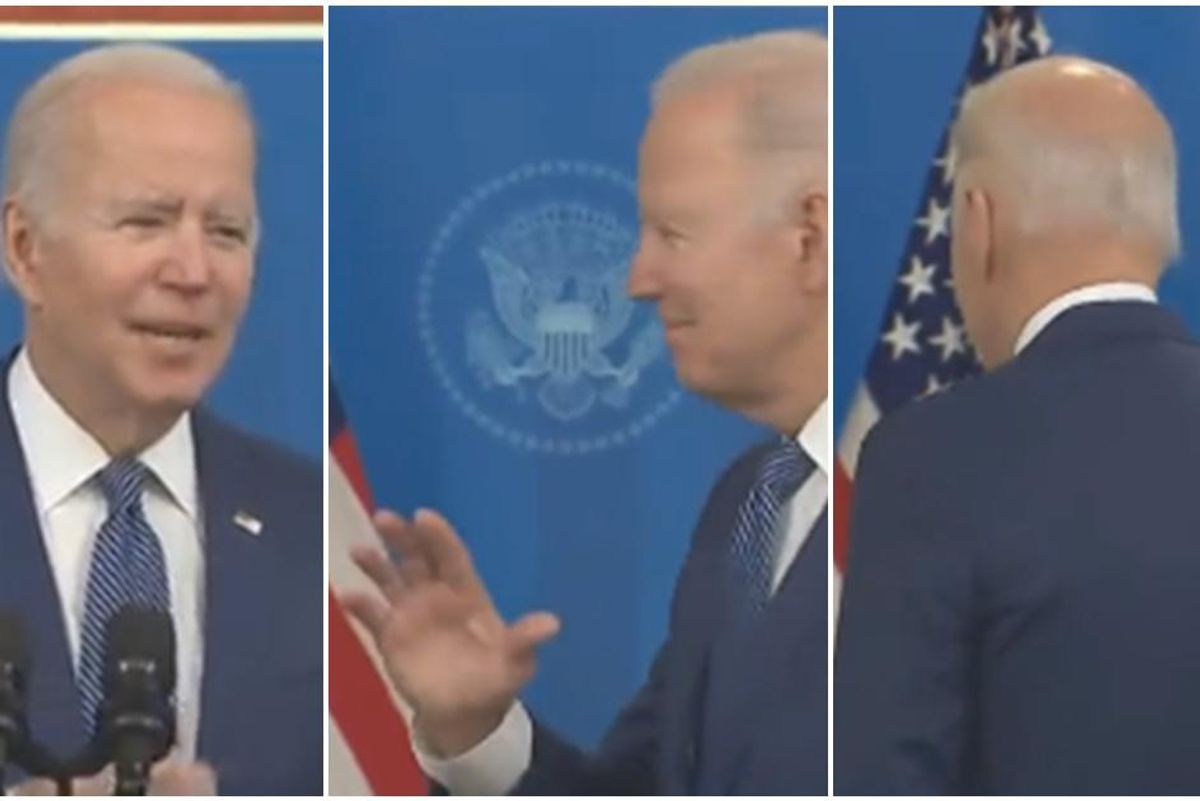Biden knew exactly what to say when asked if Trump put him at risk of catching Covid

Joe Biden at a press conference Wednesday.
A bombshell new report published in The Guardian on Wednesday alleges that former President Donald Trump may have knowingly had COVID-19 in his first debate against then-Democratic presidential candidate Joe Biden on September 29, 2020.
The allegation was made by Trump's fourth, and final, chief of staff Mark Meadows in his upcoming book, “The Chief’s Chief.” If what Meadows says is true, it means that Trump put countless lives in danger just to participate in the debate, including Biden who was 77 at the time.
In September 2020, there were no COVID-19 vaccines and treatments for the virus were less effective than they are today.
After Biden responded to a question on supply chain issues on Wednesday, a reporter asked the president about the allegation. His response was curt, to say the least.
“Mark Meadows has written a book revealing that President Trump tested positive for COVID three days before your first debate. Do you think the former president put you at risk?" the reporter asked.
“I don’t think about the former president. Thank you.” Biden said before walking away from the podium.
Reporter: "Do you think the former president put you at risk?" \n\nBiden: "I don't think about the former president."pic.twitter.com/QXCRrpnrmb— Oliver Willis (@Oliver Willis) 1638383426
In his new book, Meadows says that Trump tested positive three days before his scheduled debate with Biden. The positive test came shortly after the administration’s Rose Garden ceremony for Supreme Court nominee Amy Coney Barrett. In the days that followed, the ceremony was discovered to be a super-spreader event, with nearly a dozen people who attended the event later testing positive for the virus.
Trump and his allies learned of the result during a helicopter flight aboard Marine One for a campaign event in Middletown, Pennsylvania.
Shortly after the result came through, Meadows had the former president take another test, this time with the newer, BinaxNOW system.
After a “brief but tense wait,” the test came back negative.
On the day of the debate, the Trump team arrived late so there wasn’t enough time to test the president. The debate operated on the honor system even though each candidate was supposed to test negative for the virus within 72 hours of the start time. “Nothing was going to stop [Trump] from going out there,” Meadows said.
The White House never mentioned the positive test three days before the debate, a completely irresponsible move that mirrors Trump’s cavalier attitude in how he handled the pandemic as a leader.
Will You Shut Up Man?': Biden Blasts Trump For Interrupting.. Learn from history..pic.twitter.com/0itb6hHoUj— ALI (@ALI) 1624168860
The first Biden-Trump debate was chaotic, marked by Trump's incessant interruptions of the former vice-president. Biden also stumbled frequently during the exchange and became so frustrated with his opponent’s interjections that he demanded, "Will you shut up, man?"
Three days after the debate, Trump announced by tweet that he and his wife, Melania Trump, were positive for the virus. After a three-day stay at Walter Reed Army Medical Center, Trump was discharged and returned to the White House.
Joe Biden would go on to win the 2020 presidential election that November.
- COVD Denier Who Wanted to Prove the Virus Wasn't Serious By ... ›
- COVD Denier Who Wanted to Prove the Virus Wasn't Serious By ... ›
- Republicans Are Testing Positive for COVID at an Alarming Rate ›





 Baby boomer grandparents.via
Baby boomer grandparents.via  A stressed mom with her head in her hands.via
A stressed mom with her head in her hands.via  A stressed mom doing laundry.via
A stressed mom doing laundry.via  A father does his daughter's hair
A father does his daughter's hair A father plays chess with his daughter
A father plays chess with his daughter A dad hula hoops with his daughterAll illustrations are provided by Soosh and used with permission.
A dad hula hoops with his daughterAll illustrations are provided by Soosh and used with permission. A dad talks to his daughter while working at his deskAll illustrations are provided by Soosh and used with permission.
A dad talks to his daughter while working at his deskAll illustrations are provided by Soosh and used with permission. A dad performs a puppet show for his daughterAll illustrations are provided by Soosh and used with permission.
A dad performs a puppet show for his daughterAll illustrations are provided by Soosh and used with permission. A dad walks with his daughter on his backAll illustrations are provided by Soosh and used with permission.
A dad walks with his daughter on his backAll illustrations are provided by Soosh and used with permission. a dad carries a suitcase that his daughter holds onto
a dad carries a suitcase that his daughter holds onto A dad holds his sleeping daughterAll illustrations are provided by Soosh and used with permission.
A dad holds his sleeping daughterAll illustrations are provided by Soosh and used with permission. A superhero dad looks over his daughterAll illustrations are provided by Soosh and used with permission.
A superhero dad looks over his daughterAll illustrations are provided by Soosh and used with permission. A dad takes the small corner of the bed with his dauthterAll illustrations are provided by Soosh and used with permission.
A dad takes the small corner of the bed with his dauthterAll illustrations are provided by Soosh and used with permission. TikTok · Kyle | Website Landlord
TikTok · Kyle | Website Landlord